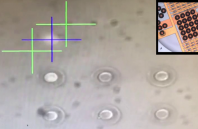A growing number of applications, including smartphone cameras, depend on microlens arrays to boost performance, for example by compensating for the “dead space” around detector pixels. However, although micro-optics are commercially available, they can be prohibitively expensive to fabricate and hard to add to existing devices. Even with traditional microlens fabrication methods such as photolithography, it is difficult to integrate lenses or to make very densely packed microlens arrays.
A newly developed technology called laser catapulting, developed at the Istituto Italiano di Tecnologia (Genova, Italy) could make it much easier and less expensive to fabricate micro-optics and tailor their properties such as shape or refractive power.1 The new laser-additive method creates microlenses each using a single laser pulse, and allows microlenses and microlens arrays to be fabricated directly on cameras or solar cells if desired.

 (585) 768-2513
(585) 768-2513

